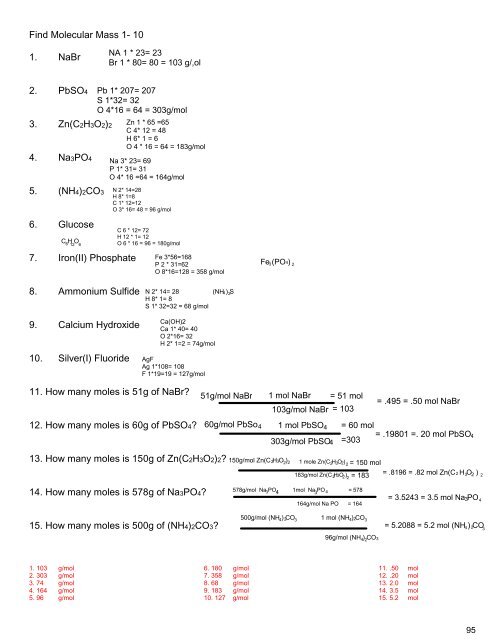You also want an ePaper? Increase the reach of your titles
YUMPU automatically turns print PDFs into web optimized ePapers that Google loves.
Learning Goal for this section:<br />
The student will learn why the mole is important and how themolecular formula of a compound can be determined<br />
experimentally.<br />
The Mole: Its History and Use<br />
Simply put, the mole represents a number. Just as the term dozen refers to the number twelve, the<br />
mole represents the number 6.02 x 10 23 . (If you're confused by the form of this number refer to our<br />
The Metric System module).<br />
Now that's a big number! While a dozen eggs will make a nice omelet, a mole of eggs will fill all of the<br />
oceans on earth more than 30 million times over. Think about it: It would take 10 billion chickens<br />
laying 10 eggs per day more than 10 billion years to lay a mole of eggs. So why would we ever use<br />
such a big number? Certainly the local donut store is not going to "supersize" your dozen by giving<br />
you a mole of jelly-filled treats.<br />
The mole is used when we're talking about numbers of atoms and molecules. Atoms and molecules<br />
are very tiny things. A drop of water the size of the period at the end of this sentence would contain<br />
10 trillion water molecules. Instead of talking about trillions and quadrillions of molecules (and more),<br />
it's much simpler to use the mole.<br />
History of the mole<br />
The number of objects in one mole, that is, 6.02 x 10 23 , is commonly referred to as Avogadro's<br />
number. Amedeo Avogadro was an Italian physics professor who proposed in 1811 that equal<br />
volumes of different gases at the same temperature contain equal numbers of molecules. About fifty<br />
years later, an Italian scientist named Stanislao Cannizzaro used Avogadro's hypothesis to develop a<br />
set of atomic weights for the known elements by comparing the masses of equal volumes of gas.<br />
Building on this work, an Austrian high school teacher named Johann Josef Loschmidt calculated the<br />
size of a molecule of air in 1865, and thus developed an estimate for the number of molecules in a<br />
given volume of air. While these early estimates have since been refined, they led to the concept of<br />
the mole - that is, the theory that in a defined mass of an element (its atomic weight) there is a<br />
precise number of atoms: Avogadro's number.<br />
Molar mass<br />
A sample of any element with a mass equal to that element's atomic weight (in grams) will contain<br />
precisely one mole of atoms (6.02 x 10 23 atoms). For example, helium has an atomic weight of 4.00<br />
amu. Therefore, 4.00 grams of helium will contain one mole of helium atoms. You can also work with<br />
fractions (or multiples) of moles:<br />
Mole/weight relationship<br />
examples using helium<br />
moles<br />
helium<br />
# helium<br />
atoms<br />
grams<br />
helium<br />
¼ 1.505 X 10 23 1g<br />
½ 3.01 X 10 23 2g<br />
1 6.02 X 10 23 4g<br />
2 1.204 X 10 24 8g<br />
10 6.02 X 10 24 40g<br />
92



